BIO120 - EXAM - ECOLOGY LECTURES
1/227
There's no tags or description
Looks like no tags are added yet.
Name | Mastery | Learn | Test | Matching | Spaced |
|---|
No study sessions yet.
228 Terms
FALSE
T/F: Ecology is a subset of environmentalism
The science of:
How organisms interact with one another and their environment
The distribution and abundance of species
The structure and function of ecosystems
The science of biodiversity
Define ecology:
Hutchinson (1965) - Means that ecology is the setting in which evolution plays out
Who wrote “The Ecological Theatre and the Evolutionary Play?” What did they mean by this?
Lynn Margulis
The idea that the mitochondria was once a free-living cell that formed a symbiotic relationship with plant cells in order to thrive
“Life did not take over the globe by combat, but by networking”
Explain the endosymbiotic theory for the origin of mitochondria. Who invented this?
8.7 million +- 1 million
How many eukaryotes are in the world?
Model Organisms: Organisms bred and used in a lab:
Mus musculus, lab mice
Drosophilia melanogaster, fruit fly
Arabidopsis thaliana
Non-Model Organisms: Essentially all other life on earth
Explain the difference of model vs. non-model organisms
All the individuals of a species in one place at one time (ex. all the zebras in a savanna)
Define Population
All of the species living together at one place and one time (ex. all the zebras, giraffes, elephants, etc. in a savanna)
Define community
All the species plus the non-living (abiotic) environment (ex. the entire savanna)
Define ecosystem
They give us resources
Allows us to predict changes alongside climate change
Allows us to predict how biodiversity will respond to habitat destruction, pollution, etc.
Determining disease risk
What is the reason we should care about species ranges?
Dispersal
Abiotic conditions
Climate
Nutrients
Species interactions
Competition
Predation
Mutualism
*All of these are GRADIENTS of conditions!
What are the three major factors that determine where species live?
“A population cannot grow faster than the resources they require”
What did Thomas Malthus state in regards to species abundance?
True! Due to humans ☹ (32% of vertibrate species are decreasing in population size, range, bird population in NA has declined by 29%)
T/F: We are currently undergoing a sixth mass extinction:
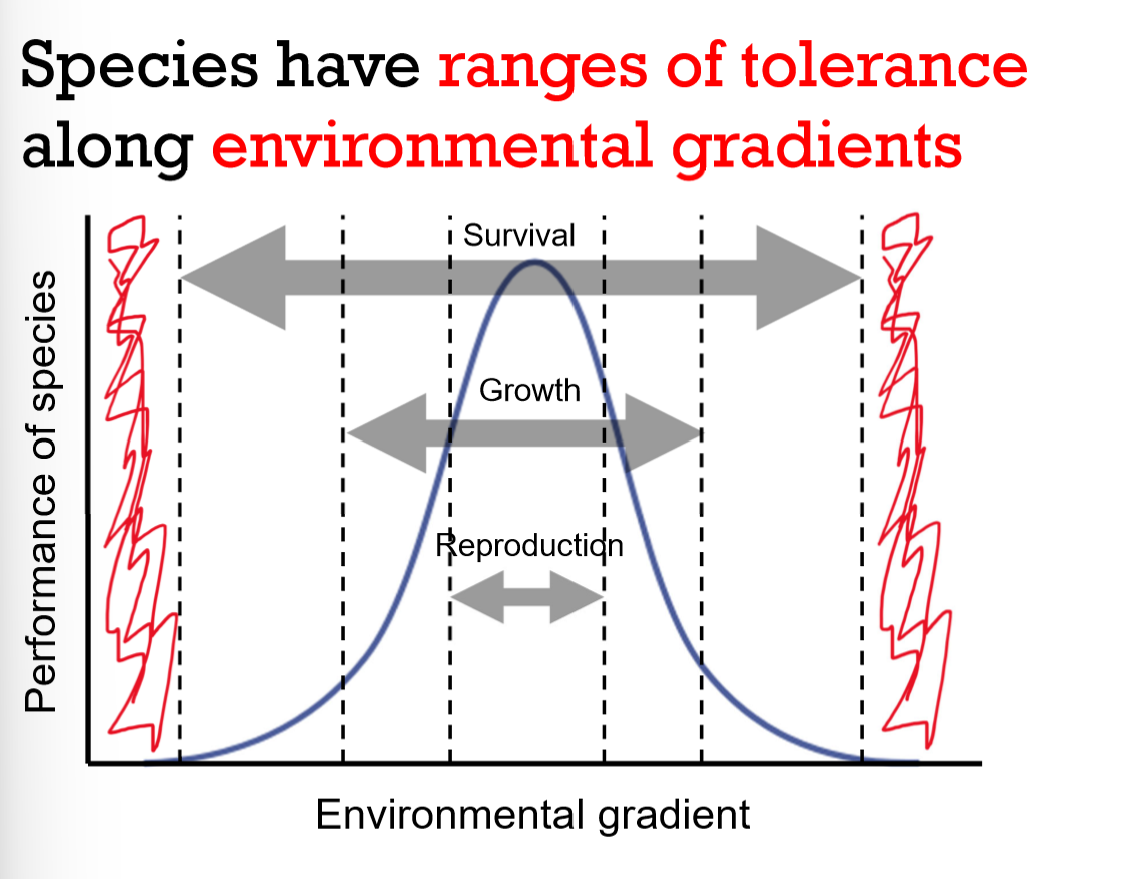
Lethal Zones (outside bell curve)
Survival
Growth
Reproduction
What are the named ranges of tolerance along environmental gradients?
The combination of physiological tolerances and resource requirements of a species
A species’ place in the world - what climate it prefers, what it eats, etc.
Define the ecological niche

Coined by G. Evelyn Hutchinson
An “n-dimensional hypervolume in which each axis is an ecological factor important to the species”
Define the Hutchinsonian niche
False, function of LATITUDE
T/F: Temperature is a function of longitude
Higher latitudes colder, seasonality a function of temperature (summer-winter)
Lower latitudes warmer, seasonality a function of rainfall (dry-wet seasons)
Explain what seasonality is a function of in different parts of the world
Atmospheric circulation, ocean currents, and rain shadows
What do rainfall levels generally depend on?
Temperature, precipitation
Which factors determine biomes?
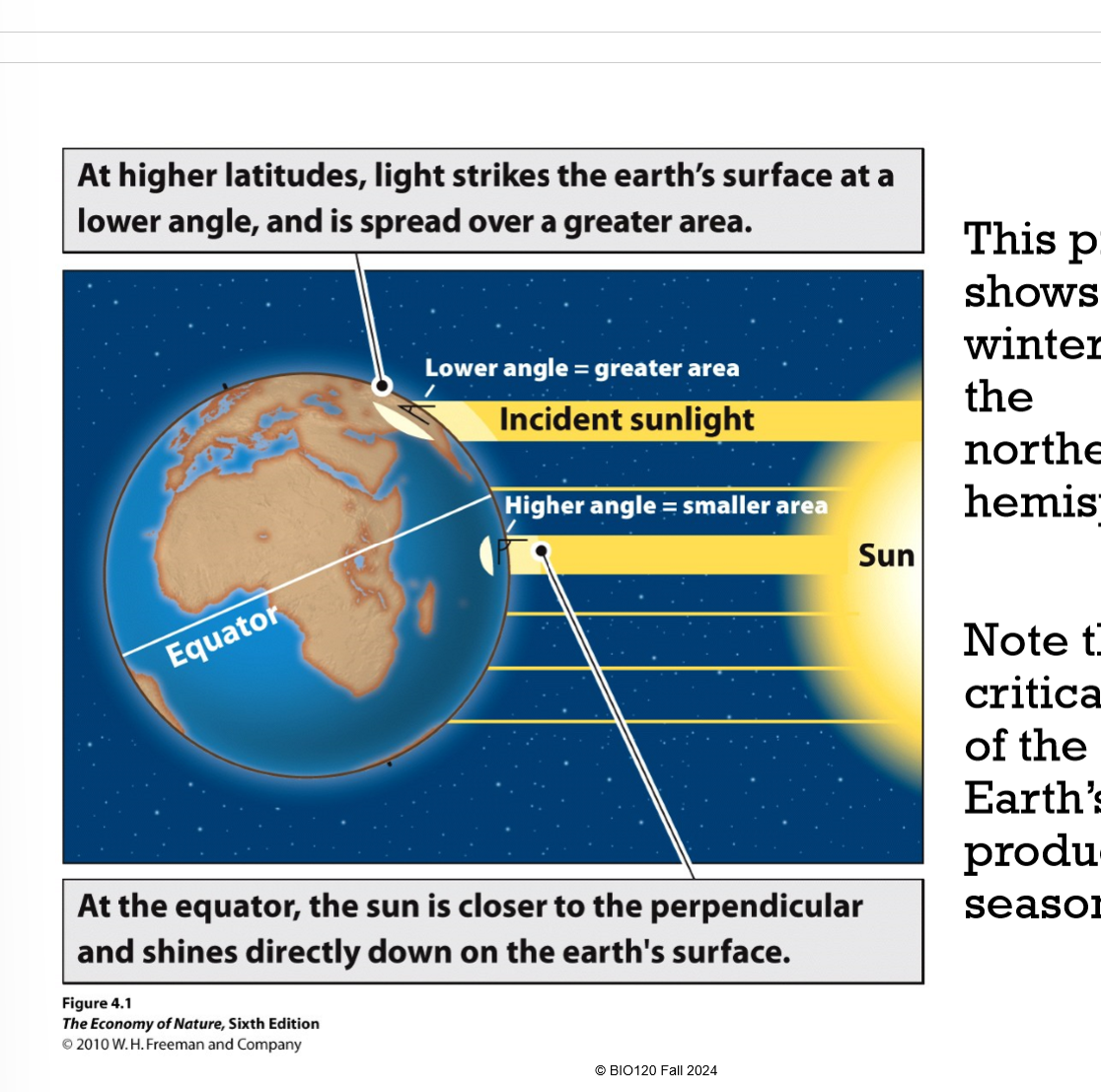
Sunlight strikes higher latitudes at an angle, dispersing the light and thus reducing the focus and the temperature increase
Sunlight strikes southern latitudes at a perpendicular angle, therefore having more focused light, thus doing more to increase the temperature
Why is it that northern latitudes are cooler?
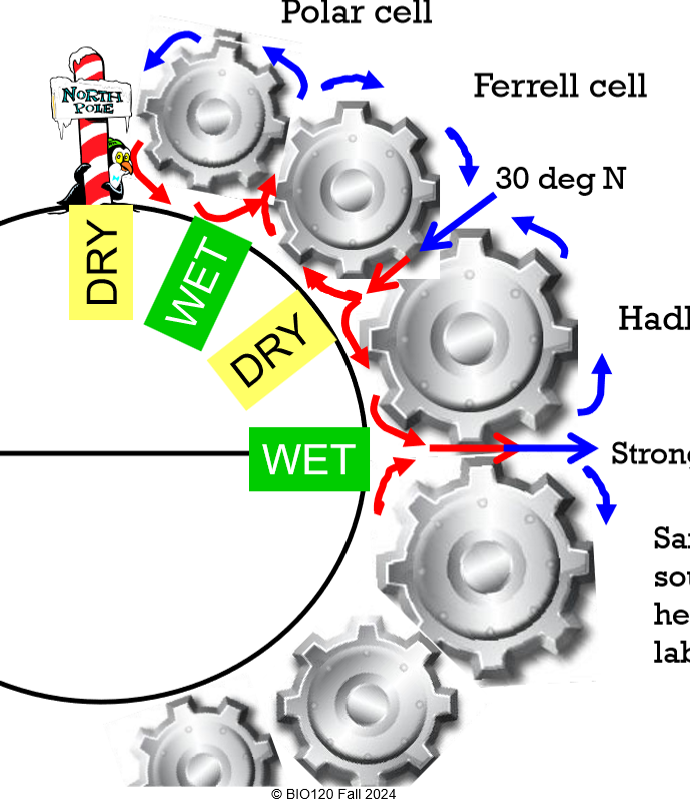
Hadley, Ferrell, Polar
Hadley-Hadley: Wet
Ferrell-Hadley: Dry
Hadley-Polar: Wet
Polar-Pole(ar): Dry
What are the atmospheric cells’ names, and at their intersection what is the dryness like?
The ITCZ appears as a line of rainclouds across the pacific, and is the line of intersection between the northeast and southeast trade winds/hadley cells (also called “doldrums”)
What is the Intertropical Convergence zone, and what does it appear as on the map?
Low seasonality in oceanic regions (S.A.), high seasonality in continental areas (asia, australia, africa)
How does the ITCZ move around throughout the year?

FALSE, other way around
T/F: Continental climates are moderate, maritime climates are extreme
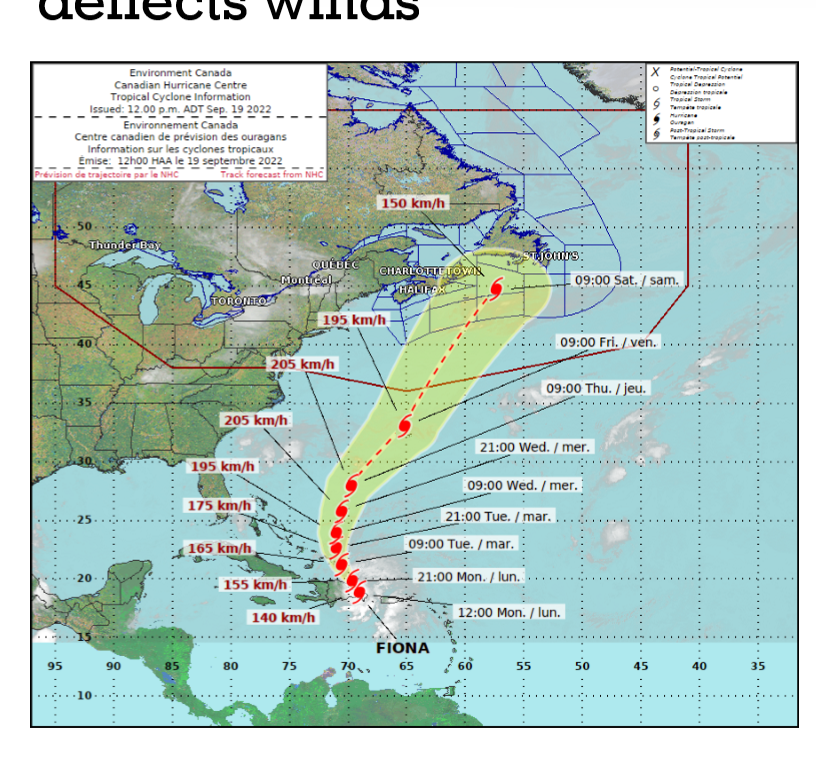
Winds appear to move eastwards as they move away from the equator and westwards as they move towards the equator
Result of the earth’s west→east spin
Explain the coriolis effect
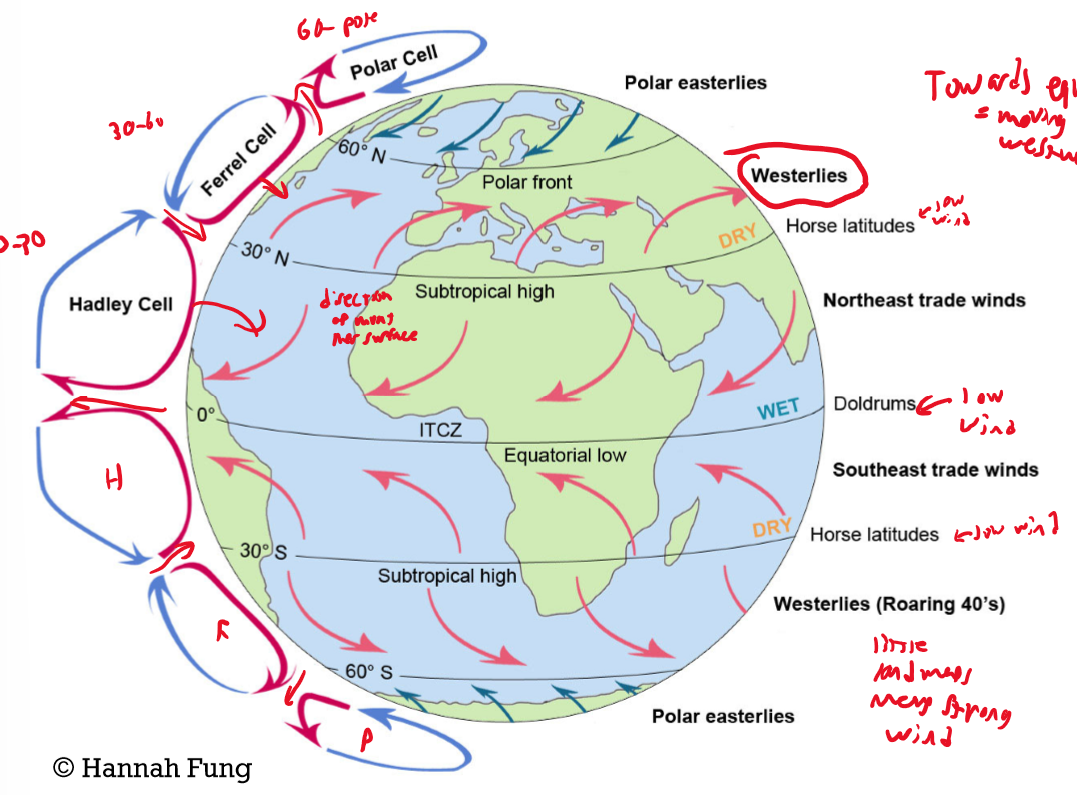
0 degrees: Doldrums/ITCZ (wet, low wind, hadley-hadley intersect)
0-30 degrees: Northeast Trade Winds (blow southwest)
30 degrees: Horse Latitudes/Subtropical High(dry, low wind, ferrell-hadley intersect)
30-60 degrees: Westerlies (blow northeast)
40 degrees: Roaring 40s (high winds)
60 degrees: Polar Front (wet, polar-ferrell intersect)
60-90 degrees: Polar easterlies (blow southwest)
*Winds are named after the direction they emerge, not the direction they travel
Fill in the “prevalining wind patterns” diagram - explain the cell, the winds, and the border name

Vegetation growth, stature, increases with moisture, temperature
Seasonality is secondarily important!
Biomes are formed with predictable characteristic vegetation
What are the general trends of terrestrial vegetation? What is the result of this?
True (sort of)
T/F: Latitude is a primary determiner of terrestrial biomes
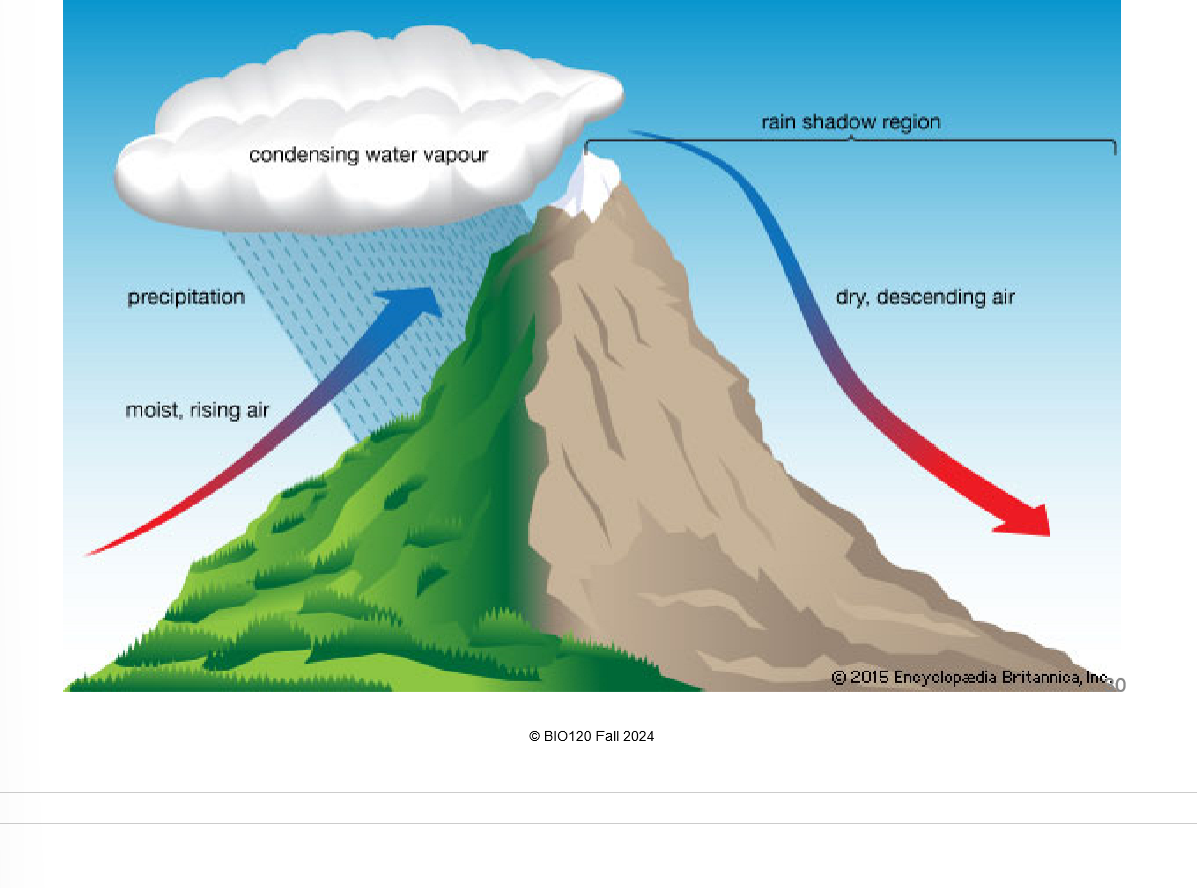
Evaporation causes moist air to rise → Undergoes cooling as it rises, thus precipitating on upper windward slopes (orthographic precipitation) → as a result of this, rain shadows form with little rainfall on leeward sides
Explain rain shadows
Ecological versatility
Recent development means limited dispersal, not at limits yet
Limited by other organisms (enemies, friends)
What are some that things that can demonstrate alternatives to geographic range limits?
Using data from a species’ present distribution to predict where it can live
Useful to model invasions, diseases, range shifts, etc.
Relies on climate data
What is ecological niche modeling (species distribution modeling)? What is it used for?
Physiology: Study how organisms acquire energy, tolerate physical conditions
Ecology: Study how organisms deal with their environment, how it limits where they live
Physiological Ecology/Ecophysiology: The study of physiology in the context of ecology
Explain Physiology, Ecology, and Physiological Ecology
An organisms physiology often reflects climate and conditions
Different solutions in different environments
Similar environments lead to similar adaptations
Explain how organisms are often seen as adaptive solutions to environmental challenges
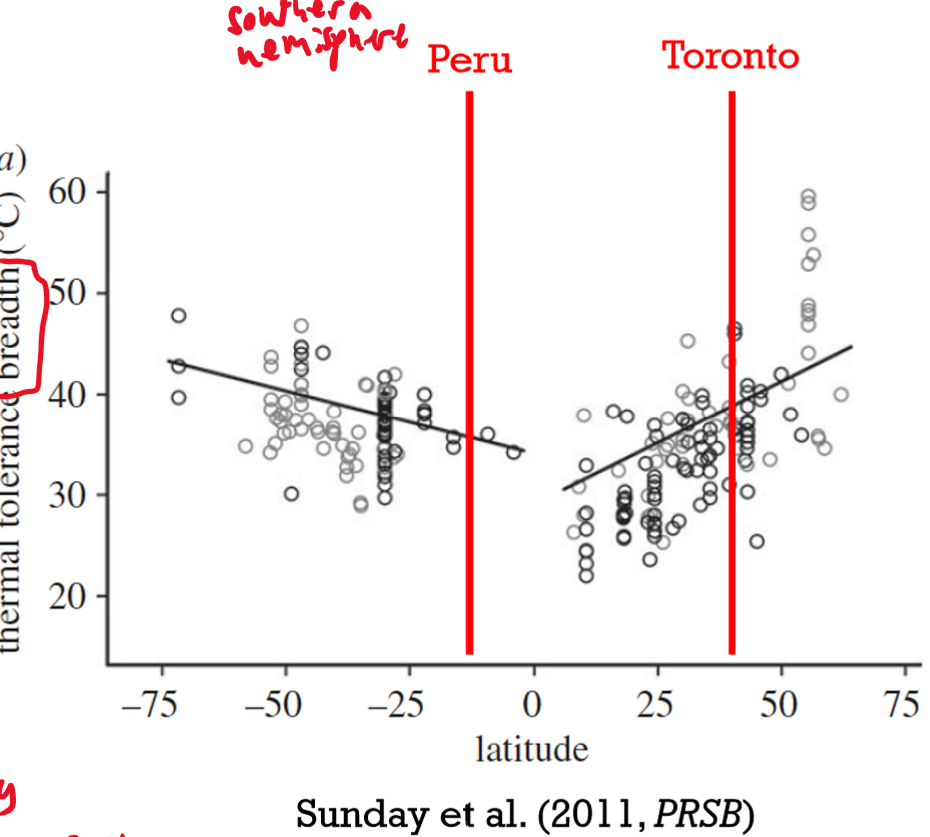
Looked at the tolerance limit of animal temperature for arthropods, reptiles, amphibians from different latitudes
Measured critical temperatures (loss of motor function)
Found that animals near poles have lower critical temperatures near poles than equator
What did Jennifer Sunday look at, and what did she find?
Poikilotherms have fluctuating internal temperatures as they cannot deviate from environmental temperatures
Homeotherms must regulate heat to keep their internal temperature within a specific range
Explain Poikilotherms vs. Homeotherms
False, other way around
T/F: A poikilotherm of one size requires more energy than a homeotherm of similar size
Radiation: Heat transfer by EM radiation (ex. the sun)
Conduction: Transfer by direct contact with surface
Convection: Heat transfer mediated by fluid (air/water)
Evaporation: Cooling from wet surfaces
Redistribution: Circulatory system redistributing heat among body parts, ex. core to appendages
What are the 5 methods of heat gain and loss?
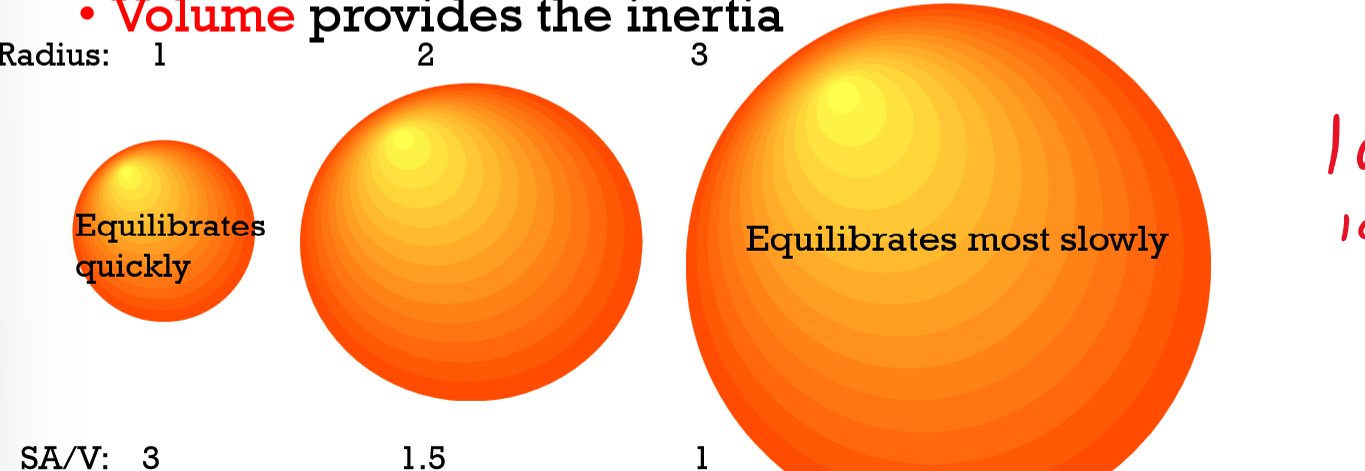
SA:V (SA/V)
Surface area determines rate at which heat is gained/lost
Volume determines how much heat an organism has to lose
Large bodies lose heat slower
What is the ratio determining heat balance? What does each part contribute?
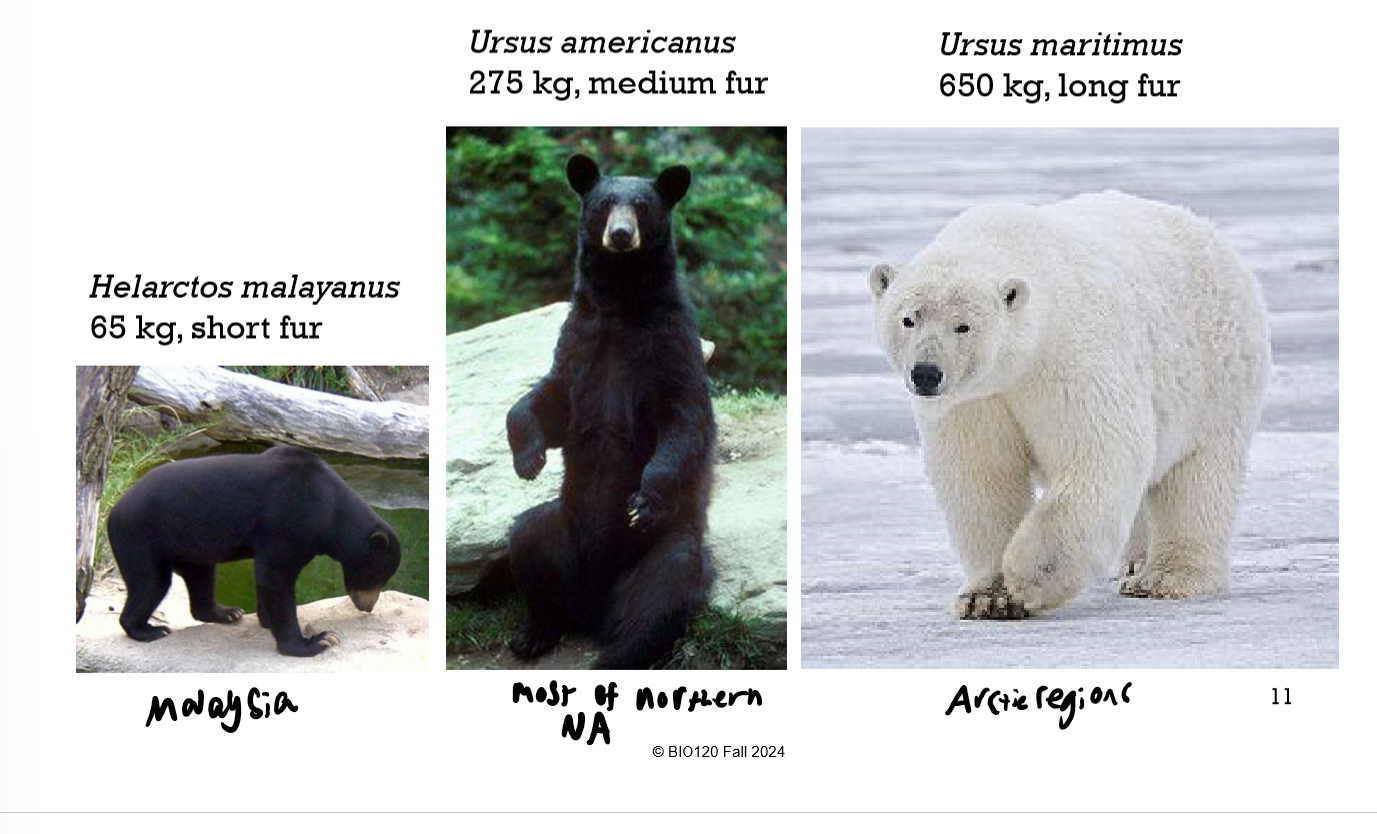
Homeotherms tend to be larger at higher latitudes (ex. bears)
Larger body means more heat that can be saved
Explain Bergmann’s Rule
Sometimes SA is needed for function (ex. Chrysopelea gliding snake)
Tradeoff
Why is surface area sometimes chosen over volume? Why aren’t homeotherms always spheres in cold climates?
Maximum (high SA, low V): Gliding snake
Restricted to tropics due to not needing to conserve heat
Minimum (low SA, low V): American Pika
Restricted to cold habitats
What species have the maximimum, minimum SA:V ratio?
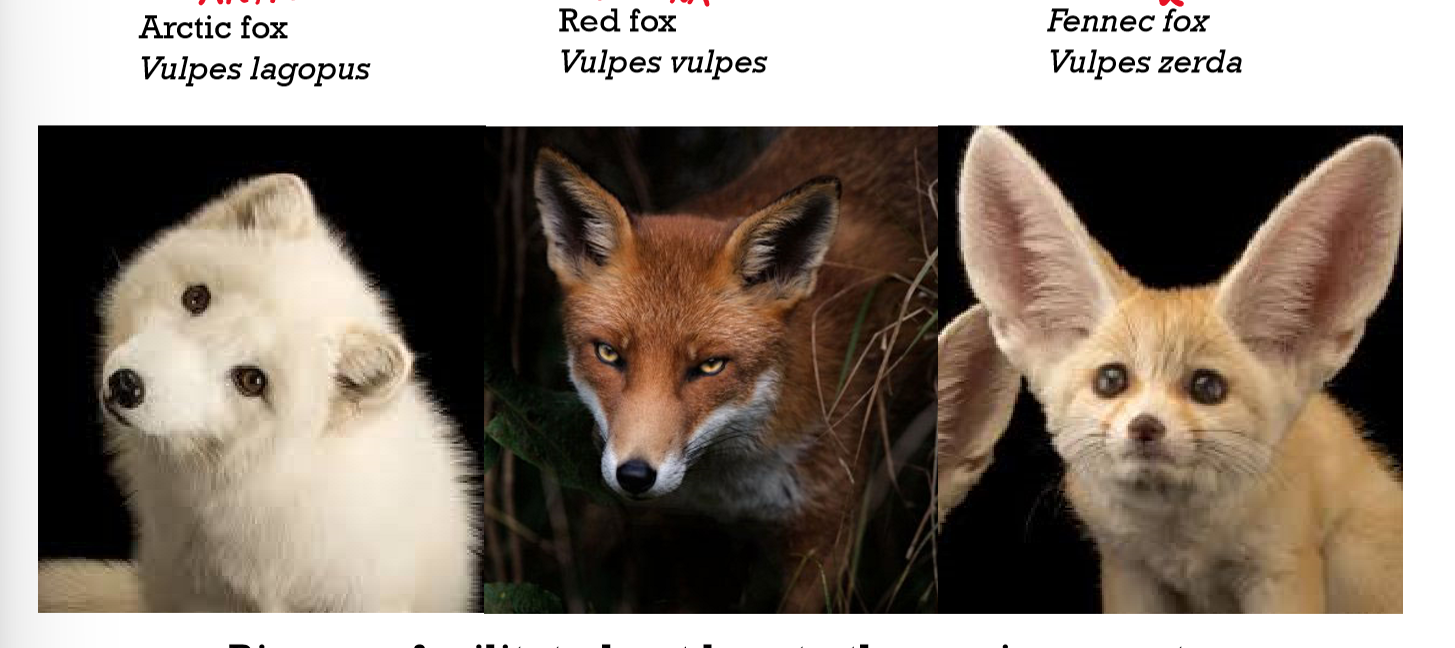
Homeotherms have smaller appendages at colder latitudes - big appendages facilitate quicker heat loss
Explain Allen’s Rule

Insulation (fur, feathers, blubber, wool)
Convective cooling via vascularization
Countercurrent circulation
Arteries and veins are close together such that heat always both flows to appendages and from appendages
Evaporative Cooling/Behaviour (sweat, shade seeking)
What other factors matter for heat conservation?
Obtain energy from hunting, and thus trades heat conservation of a prey animal to be an excellent winter hunter (sorry gophers)
Fitness gains of hunting offset the fitness costs of expensive metabolism
Why are weasels small (low volume, high SA), yet live in cold climates?
Trade offs
Constraints
What are the two main reasons that natural selection produces imperfect organisms?
Plants are sessile, unable to escape conditions
Autotrophic, produce their own food
Need identical resources to grow (CO2, water, NPK)
Why is plant ecophysiology different than animal ecophysiology?
CO2 + H2O + light is brought together in photosynthetic tissues to produce carbs and O2, then use carbs and oxygen to produce ATP to power photosynthesis
Must maintain a carbon balance (more carbon gained through photosynthesis than lost through respiration)
How does photosynthesis work?
Carbon gained through photosynthesis - Carbon lost via respiration = NPP
What is Net Primary Productivity?
Sink: Removes/Stores CO2
Source: Produces CO2
Define Carbon Sinks and Carbon Sources
Photosynthetic structures (stems, leaves) take CO2 in through stomata, but also lose water and O2 through them
How do photosynthetic structures work?
False
T/F: Leaf SA:V is irrelevant
Benefits: Good for harvesting light, CO2
Costs: Bad for overheating, transpiration
What are the costs and benefits of large leaves?
Carbon fixing through C3 photosynthesis
Uses Rubisco
At high temperatures, can accidentally cause photorespiration, and take O2 while producing CO2
Some plants have evolved other methods, such as:
C4 photosynthesis: PEP carboxylase accepts CO2 prior, thus reducing photorespiration
CAM photosynthesis: Plants close stomata in the day to conserve water, store CO2 at night, store it as malate until daytime
How do plants cope with overheating and water loss?
Overheating: Grow in shadier habitats - Evaporative cooling by opening stomata
Close stomata - tradeoff between water conservation and rapid growth (risks overheating, tissue damage, shuts down gas exchange)
How do plants with LARGE LEAVES combat overheating and water loss?
“green stick”
Tree adapted to the desert, has photosynthetic bark on trunks, branches
Can grow without heat load and water loss of leaves
Microphylly (tiny leaves)
What is a Palo Verde, and what is its defining feature?
False, due to the tradeoffs it is more efficient for warm and humid areas to have larger leaves
T/F: Lower precipitation = larger leaves
True (ex. cacti)
T/F: Some plants have no leaves, and just photosynthesize using the plant features itself
Plants evolve with high water absorption, low water loss features, etc.
How does episodic rainfall affect plant growth?
Cacti: In order to gather as much water as possible
Tropical Trees: Layer of nutrient rich soil, which is exploited by long, shallow roots
Why do cacti have shallow roots? Why do tropical trees have shallow roots?
Rebecca Doyle
Found that legume species will emulate “foraging” for nitrogen rich soil with nitrogen fixation
Who performed the experiment for Root “foraging”, and what did they find?
Plants drop leaves during dry, cold seasons to reduce water stress and tissue damage
Define the “Deciduous habit”
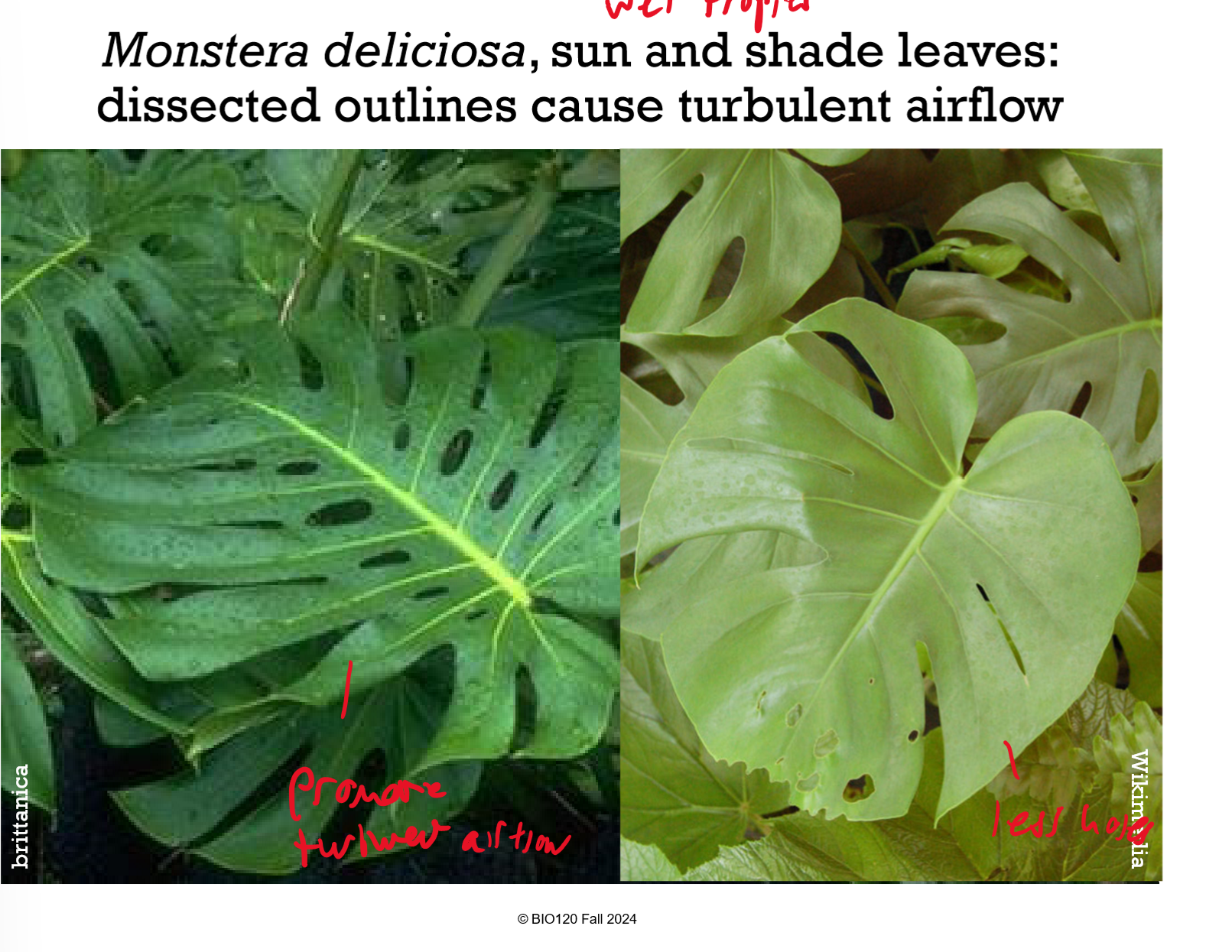
Laminar vs. turbulent airflow matters for gas exchange
More turbulent airflow allows for more gas exchange and leaf cooling, hence why plants in the sun often have sharp and turbulent edges
How does airflow matter for leaves?
Plants growing on other plants
Nonstandard nutrient gathering
Bad if too heavy, plentiful
Cannot place roots in soil
Define and explain Epiphytes
FALSE, not being able to put roots in the soil means that they cannot always take nutrients and water from the soil
T/F: Epiphytes do not face water stress or nutrient shortages
Population Size: N (number of individuals)
Population Density: N/Area
What is the notation for Population and Population Density?
Natural resource management (fish stocks, pests)
Conservation (species decline)
Health (monitoring populations of bacteria)
Predicting human growth
What is the relevance of population size?
Pink Salmon
What did Marty Krkosek study?
A “time series”
What is a graph called when the x axis is time and the y axis is abundance?
Explosive growth in the human population would have catastrophic social and environmental consequences
What did Paul Ehrlich argue in The Population Bomb?
To predict N as a function of t, or the population growth through time
Ex. How many individuals are in the population now? (Nt) vs. how many individuals one step from now? (Nt+1)
What is the goal of most population models?
Nt+1 = f(Nt)
What is the simplest possible general model for population models?
Continuous-Time: Using differential equations, infinitesimally small time steps, calculated with calculus concepts - suited for species with continuous reproduction
Discrete-time: Using difference equations, discrete unit time steps - suited for episodic reproduction
What are the two time approaches that can be used? What are they best suited for?
Function notation: N(t)
What other method can be used for time step notation?
t=0, N0, N(0)
How is the starting population represented notationally?
Nt = N0λt
where:
λ is the finite rate of increase
λ>1, births exceed deaths and population grows
λ<1 deaths exceed births and population shrinks
What is the Geometric Growth Model?
Nt = N0ert,
where:
r = “Intrinsic Rate of Increase” (per-capita rate of population change b-d)
Where:
r>1, population is growing
0<r<1 population is shrinking
What is the exponential growth model?
ln(λ) = r
How to convert between intrinsic and finite rate of increase?
It all depends on what better models the biology
For what reason would you choose one graphical model (geometric vs. exponential) over the other?
False, all species can grow under good conditions, shrink under bad ones
T/F: Species have guaranteed λ values no matter the situation
TRUE
T/F: No species consistently maintains λ>1, λ<0 for long periods
TRUE, it is impossible for a population to have uninhibited exponential growth
T/F: Exponential growth models are ultimately not well-structured models
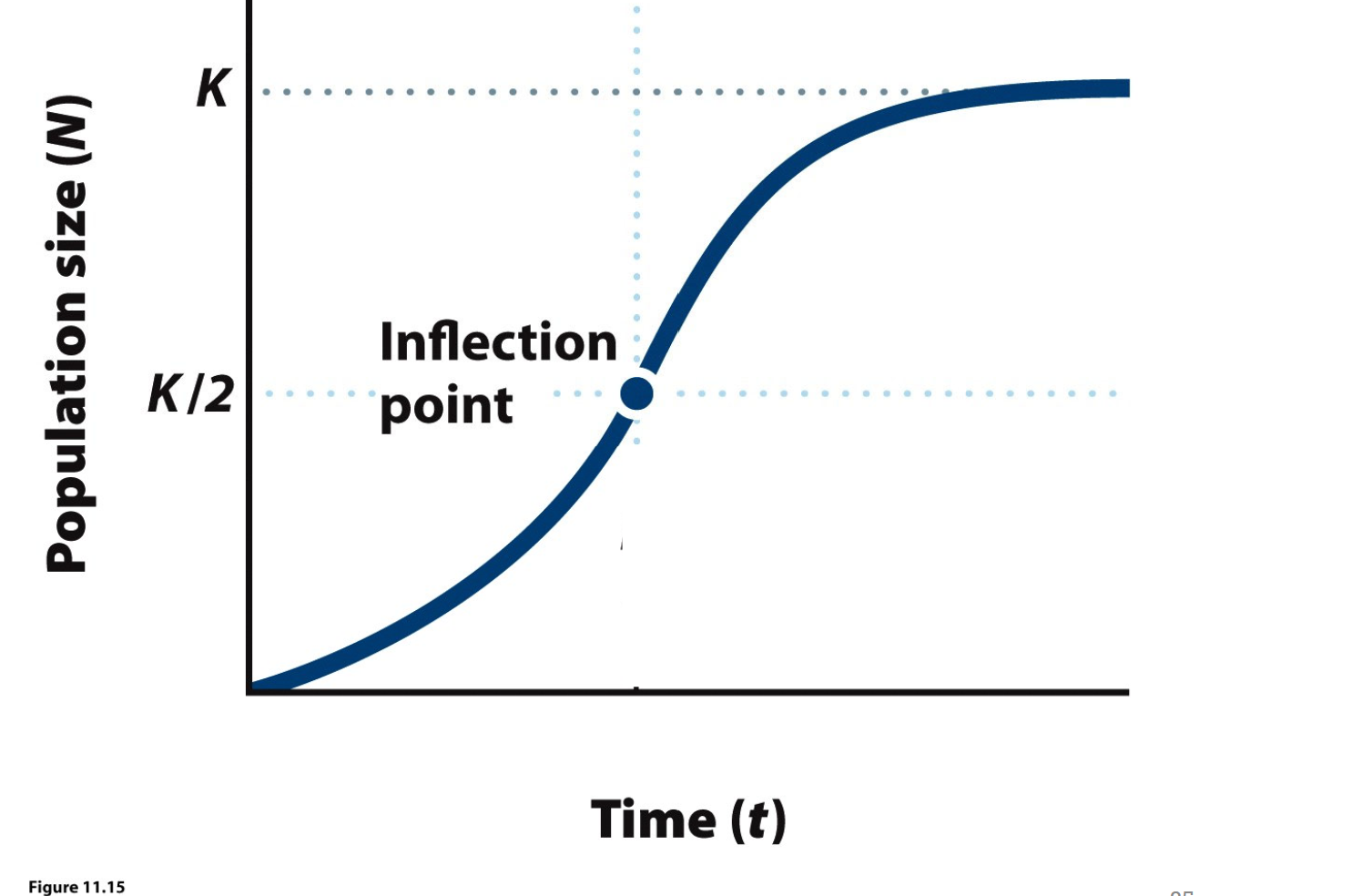
A model that produces a SIGMOID GROWTH CURVE (s-shape) - produced by adding a “stop” term to an exponential growth model’s slope
Slope is highest at inflection point
For this model,
N = population size
K = carrying capacity
r = intrinsic rate of growth
t = time
What is the logistic growth model?
(1-N/K) → no braking at low density (1-0/k) vs complete braking (term = 0) as n approaches k (1-k/k = 0)
How is density dependence modeled in logistic curves?
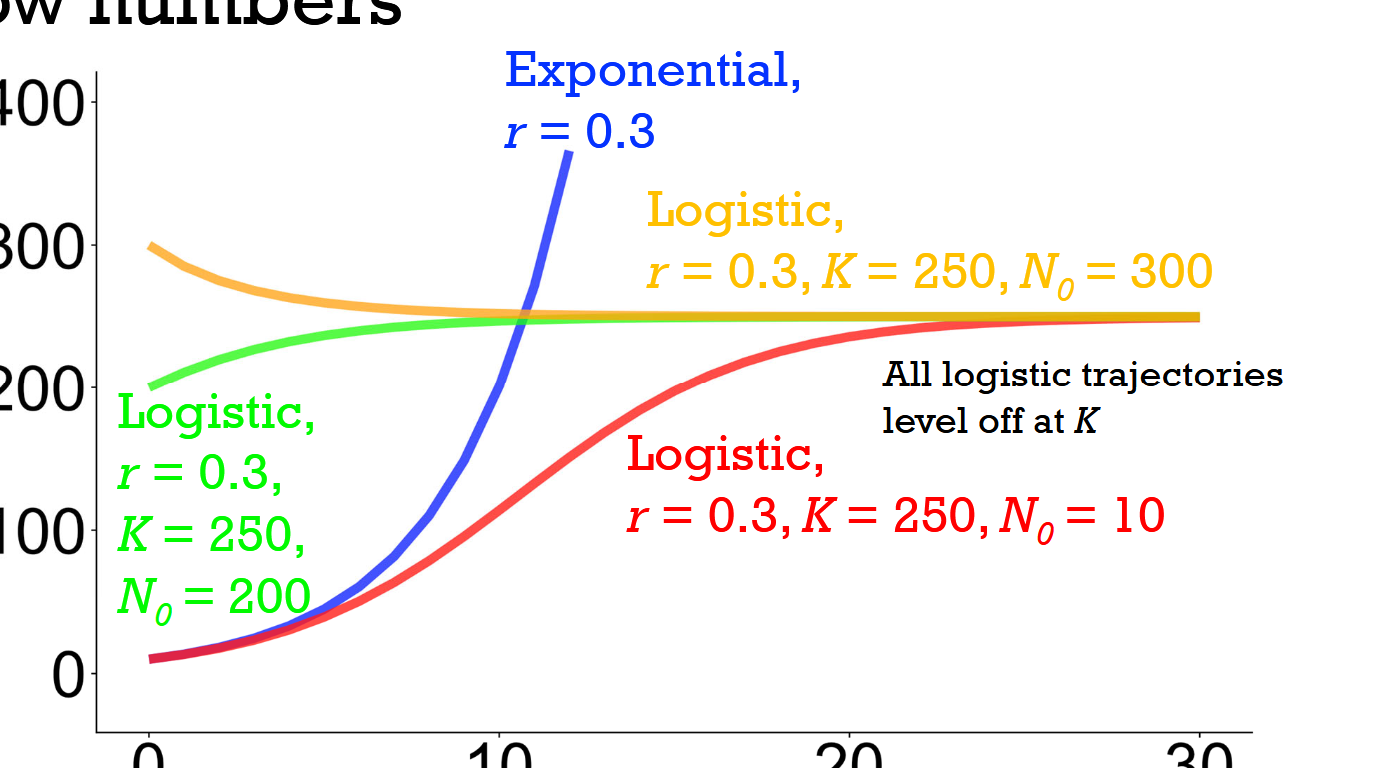
False, only logistic when starting from low values, as will always level off at k
T/F: Logistic trajectories are ALWAYS s-shaped
Pros: Simple, Mathematically tractable, expandable to consider multispecies competition
Cons: too simple, always has a gradual approach despite real life nonlinearity
What are the pros and cons of a logistic growth model?
Allee effects
Time lags
Species interactions
What ways can more complexity be added to population growth models?
FALSE, some things such as allee effects can be detrimental
T/F: Low density is always beneficial for growth
Negative effects of low density, usually from social benefits in high density (ex. mate finding, group living)
Define an Allee Effect
Populations fluctuating between K and a lower limit, and going extinct when passing below the lower limit
How is minimum density dependence represented in modeling?

Fecundity and survivorship depend on age, and not all individuals have equal probability of birth/death
Species also have life history strategies (ex. lifespan, reproduction timing, numbr of offspring, parental investment)
In terms of age, why are exponential/logistic models not representative of real populations?
Start at small size
Grow for period without reproducing (resource accumulation)
Start spending resources on reproduction
Some spend their resources all at once, some spread them out
Explain the typical life history for plants and animals
Life history evolution
Conservation
Understanding human demography
What implications does age-structured population growth provide us with?
Age-class intervals, an arbitrary unit chosen to give a reasonable # of age classes for an organism
For humans, ~5 year intervals (about 20 age classes)
For non-logistic/exponential models, how is time measured?
Data summarizing life events that are statistically expected for the average individual
Age of death
Age, timing of reproduction
Constants in modeling
Considers females only
What do life tables typically contain?
Age classes: subscript x
lx: The probability of being alive at age x
l0: 1.0 (by definition)
“Survivorship Curve: Graph of lx vs x
Note: shape of lx curve depends on species, and lx must decline with x
What are the notations and features of survivorship schedules?
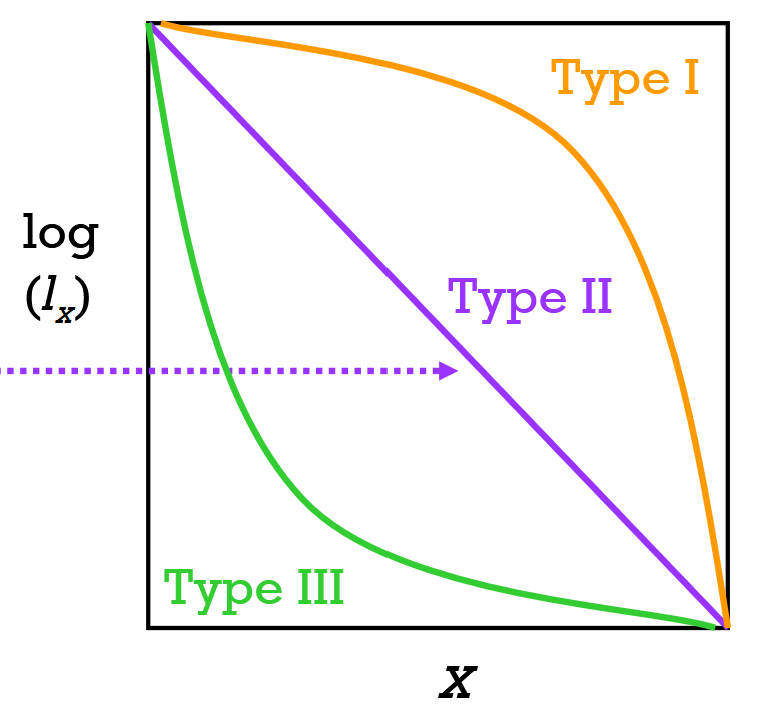
Type 1: Low early mortality, high late mortality (ex. humans)
Type 2: Constant mortality at all ages (die spontaneously)
Type 3: High early mortality, low late mortality (ex. turtles)
What are the 3 types of survivorship curves?

False, graphs are generally more complex
T/F: Types 1-3 survivor ship curves are perfectly accurate
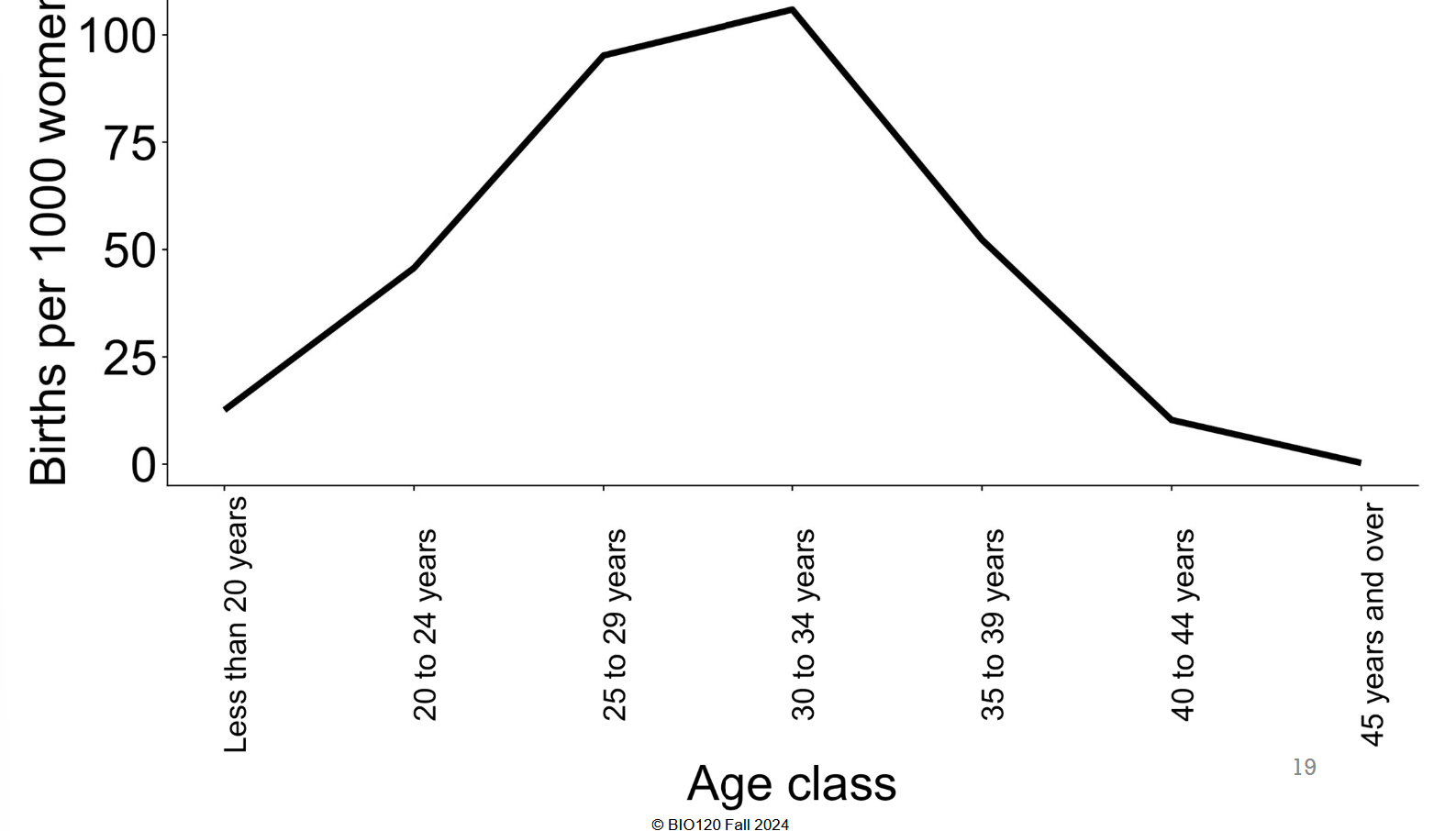
Age classes denoted by subscript x
mx (or bx): # of daughters born to a female of age x during interval x to x+1
Shape of mx curve dependent on species
Reproductive periods are usually preceded by resource accumulation phase
Cost of reproduction: Tradeoff between fecundity-survivorship
Describe the notation and features of fecundity schedules